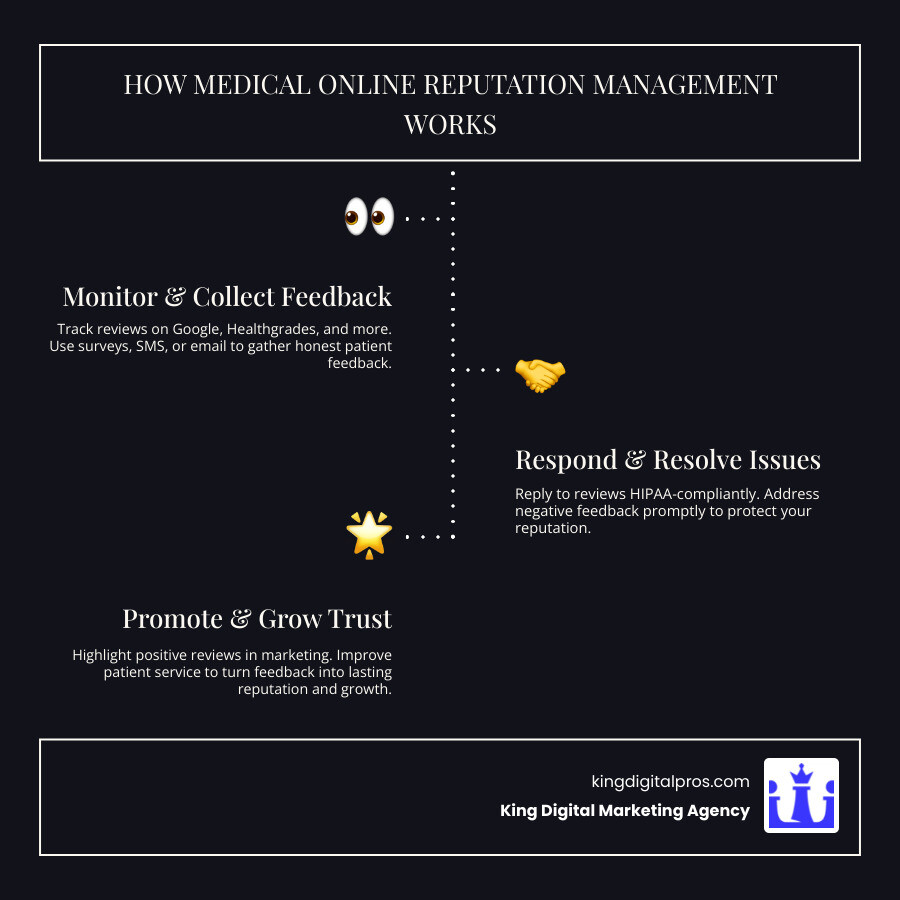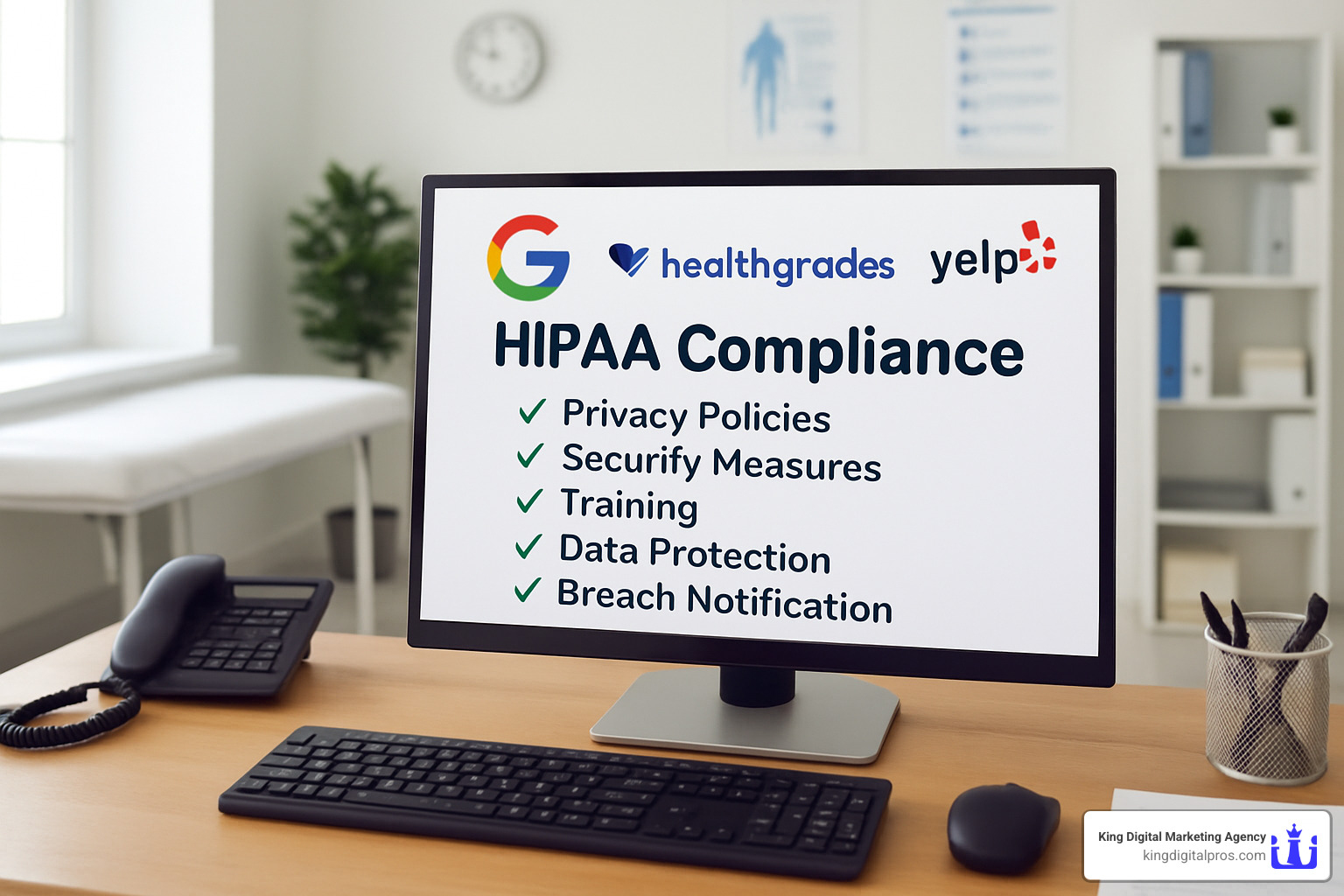What Is Medical Online Reputation Management? (And Why It Matters for Every Practice)
Medical online reputation management is how doctors and healthcare clinics control, protect, and grow their online public image—especially on Google, Healthgrades, WebMD, Facebook, Yelp, and specialty review sites. It’s about shaping what current and future patients see when they search for you online.
If you just want the “quick answer” about medical online reputation management, here’s what you need to know:
| What Is It? | Why Is It Important? | How Do You Do It? |
|---|---|---|
| Monitoring, improving, and protecting your practice’s online reviews and listings | 90% of patients read online reviews before picking a provider; one negative review can cost you dozens of new patients | Collect feedback from patients, address problems fast, reply to reviews (without violating privacy), and use automation software to save time and stay compliant |
In plain English:
Medical online reputation management means making sure your reviews, listings, and patient feedback tell the best possible story about your practice—so you attract new patients, build trust, and avoid costly mistakes.
“To a patient looking for the right doctor or medical practice, the decision can seem like a life or death situation—so you can bet that 90% of your potential patients are combing carefully through all of your online reviews before deciding to call you, or a different doctor.”
In this guide, you’ll learn:
- Why online reputation is the #1 factor in patient choice today
- Which review platforms matter most in healthcare
- How to collect more positive reviews (and fewer negatives)—ethically and HIPAA-compliantly
- Strategies to respond to reviews without risking privacy
- How automation and best-in-class tools make this simple
I’m Bernadette King, founder of King Digital Marketing Agency. I’ve helped local clinics, medical groups, and franchise owners improve search visibility and patient trust with proven medical online reputation management strategies.

What You’ll Learn
By the end of this guide, you’ll have actionable answers to the key questions every healthcare provider faces:
- How to ethically encourage positive patient reviews while staying HIPAA compliant
- The best way to respond to negative reviews without violating patient privacy
- Which review platforms deserve your attention and monitoring
- How to automate your reputation management process effectively
- What features to look for in reputation management software
- How to use patient feedback to improve your overall service quality
Why Reputation Rules in Healthcare
Picture this: Someone in your community needs a new doctor. They’re sitting at their computer, maybe feeling anxious about their health, and they type your practice name into Google. What they see in those first few seconds will determine whether they call you or keep scrolling to find someone else.
Here’s the reality that’s reshaping healthcare: 90% of potential patients read online reviews before choosing a doctor. This isn’t just another marketing statistic—it’s the new normal in healthcare decision-making. When people need medical care, they’re not just picking a provider; they’re making what feels like a life-or-death decision about who to trust with their health.
The numbers behind medical online reputation management are eye-opening. One negative review can cause an average loss of 30 customers. Even more striking, a single bad review can lead to a one-third decline in appointments. To put this in perspective, you need approximately 40 five-star reviews to counteract the impact of just one negative review.
According to research from Harvard Business Review, online reviews have fundamentally changed how consumers make purchasing decisions across all industries. In healthcare, the stakes are even higher because patients are often vulnerable, anxious, and desperately seeking reassurance about their choice.
What makes healthcare reputation particularly challenging is that patient satisfaction isn’t just about clinical outcomes. Only 22% of negative reviews are actually related to patient-physician interactions. The majority of unhappy patients who post negative feedback are upset about billing issues, rude front desk staff, long wait times, paperwork problems, lack of patient focus, and impolite responses from non-physician staff.
This means that even excellent doctors with outstanding clinical skills can suffer from poor online reputations due to administrative hiccups. It’s frustrating, but it’s also fixable with the right approach.
Consequences of Neglect
Ignoring your online reputation isn’t just risky—it can be devastating for your practice. Appointment loss hits first and hardest. Research shows that practices can see up to a 33% decline in new patient appointments from a single negative review.
Brand damage extends far beyond individual appointment bookings. Negative reviews create a cloud over your entire practice reputation, making it harder to attract top talent and build community trust.
Referral decline is perhaps the most insidious consequence. Other physicians and healthcare professionals also read online reviews when considering referrals.
Benefits of Proactive Strategy
Practices that take a proactive approach to medical online reputation management see measurable benefits that extend far beyond just looking good online.
Higher star ratings come naturally when you have a systematic approach to review collection. Practices with organized reputation management typically maintain ratings between 4.5-4.9 stars, which research shows provides the best return on investment.
SEO lift happens when positive reviews and active engagement on review platforms improve your local search rankings. Google’s algorithm considers review quantity, quality, and recency when determining local search results.
Trust and loyalty develop when patients see that you actively respond to feedback—both positive and negative. This engagement shows that you care about patient experience and are committed to continuous improvement.
Medical Online Reputation Management Basics: Platforms, Policies & Listening Posts

Think of medical online reputation management as setting up a sophisticated early warning system. You need to know where conversations about your practice are happening, what the rules are for engaging safely, and how to turn feedback into opportunity.
The challenge is that patients don’t stick to just one platform when sharing their experiences. They might leave a Google review after their appointment, post on Facebook about their wait time, or rate you on Healthgrades months later.
Must-Watch Review Channels
Google Business Profile is your digital front door—it’s where most patients will encounter your practice first. When someone searches for healthcare providers in your area, Google reviews appear prominently in search results and the local map pack. Setting up and optimizing your Google My Business profile should be your absolute first priority.
Healthcare-specific directories carry extra weight because patients trust them for medical decisions. Healthgrades is the largest online resource for information about physicians and hospitals, while WebMD is widely trusted by patients for medical information and provider reviews. Vitals has become increasingly popular for patient reviews and physician ratings.
Don’t overlook general platforms either. Facebook reviews often surprise practices because patients leave detailed feedback on practice pages, and Yelp remains relevant for healthcare, especially in urban areas.
Staying HIPAA-Compliant While Encouraging Reviews
Here’s where many practices freeze up—and I get it. HIPAA violations can be devastating, but compliance doesn’t mean you can’t actively encourage reviews. The key is understanding the boundaries and staying well within them.
Consent language should always be general when asking for reviews. Never mention specific treatments, conditions, or visit details. A simple “We’d appreciate your feedback about your experience with our practice” keeps you in the clear. According to HHS guidance on HIPAA and online reviews, you can ask patients to post reviews as long as you don’t specify what they should say about their care.
De-identification is crucial when responding to reviews. Never include any information that could identify the patient or their medical situation. Stick to general statements about your practice’s commitment to quality care.
For detailed feedback that might involve protected health information, always direct patients to private channels like secure patient portals or direct communication with practice management.
Decision Tree: Positive vs. Negative Feedback
Smart practices use what I call a “feedback first” approach to catch issues before they become negative online reviews.
The process starts with an immediate post-visit survey where you ask every patient about their experience before they leave. When patients give you a positive response (8-10 out of 10), that’s your green light to direct them to leave a review on your preferred platform.
Neutral responses (6-7 out of 10) deserve private follow-up to understand concerns. Negative responses (1-5 out of 10) should immediately escalate to practice management for service recovery. The goal is to address problems while patients are still in your office, preventing many negative reviews from ever being posted online.
Responding to Reviews Without Violating Privacy

Here’s where many healthcare providers freeze up—and I totally get it. The fear of accidentally violating HIPAA while responding to reviews keeps many doctors from engaging with patient feedback at all. But here’s the thing: you can absolutely respond to reviews professionally and empathetically without crossing any privacy lines.
The secret is staying completely generic. Think of your response as a public statement about your practice’s values, not a conversation with the specific patient. You’re showing future patients how you handle concerns, not addressing the reviewer’s medical details.
Empathy first, brevity second should be your mantra. A short, caring response often works better than a long explanation. Defensive responses make you look bad to everyone reading them—not just the unhappy patient.
Turning Negatives into Opportunities
Here’s something that might surprise you: 78% of negative reviews in healthcare stem from administrative issues, not clinical care problems. That’s actually fantastic news because administrative problems are usually much easier to fix than medical ones.
When someone complains about your front desk staff, billing confusion, or long wait times, you’re getting free consulting advice on how to improve your practice. Even better, when you respond professionally to these complaints, you’re showing potential patients that you actually care about their experience.
Root-cause analysis becomes your best friend here. Look for patterns in negative feedback. Are multiple patients complaining about the same issue? That’s not a coincidence—it’s a workflow problem you can fix.
Sample Templates Featuring Medical Online Reputation Management Best Practices
Let me share some response templates that work beautifully for medical online reputation management. These have been tested across hundreds of healthcare practices, and they strike the right balance between professionalism and warmth.
For service or administrative complaints: “Thank you for taking the time to share your feedback. We’re sorry your experience didn’t meet the high standards we set for our practice. Please contact our office manager directly at [phone] so we can address your concerns and improve our service.”
For wait time complaints: “We apologize for the extended wait time during your visit. We understand how valuable your time is and are working to improve our scheduling system. Please reach out to us directly so we can discuss your experience further.”
For billing issues: “We’re sorry for any confusion regarding your billing. Our billing department takes these matters seriously and would like to resolve this with you directly. Please call [number] and ask for our billing manager.”
Notice how each template acknowledges the problem without getting defensive, takes responsibility for the patient’s experience, and offers a private path forward. You’re never discussing medical details, but you’re showing genuine concern for patient satisfaction.
Timeline guidance is crucial here. Aim to respond within 24-48 hours maximum. Quick responses show that you’re actively monitoring feedback and care about patient concerns.
Automating Success with Medical Online Reputation Management Software & Workflows

Let’s be honest—manually managing your medical online reputation management is like trying to keep track of every conversation in a busy restaurant. You’ll miss things, responses will be delayed, and your staff will burn out fast. The good news? Automation can handle the heavy lifting while you focus on what matters most: taking care of patients.
The right software turns reputation management from a daily headache into a smooth, systematic process. Instead of remembering to ask every patient for a review, worrying about missed negative feedback, or scrambling to respond to reviews at 10 PM, you can set up workflows that work around the clock.
Must-Have Features Checklist
When you’re shopping for reputation management software, you need to think like a busy practice manager. What would make your life easier? What would actually get used by your staff?
Review request automation is the foundation of any good system. The software should automatically send review requests via SMS and email after patient visits, with timing you can customize.
Two-way texting might sound fancy, but it’s incredibly practical. Patients can respond to review requests directly, and you can have quick conversations about their experience. This often prevents negative reviews from ever reaching public platforms.
Dashboard analytics give you the big picture without drowning you in data. You want real-time monitoring of reviews across all platforms, with sentiment analysis that actually makes sense.
HIPAA compliance isn’t negotiable—any software you use must have proper Business Associate Agreements (BAAs). Don’t even consider a system that can’t provide this documentation.
EMR integration eliminates the manual data entry that kills productivity. The best systems connect directly with your electronic medical records to automatically trigger review requests without your staff lifting a finger.
Negative review interception is perhaps the most valuable feature. Before directing patients to public review sites, smart systems screen for satisfaction levels and route unhappy patients to private feedback channels where you can address their concerns.
Building a Scalable Workflow
Creating a systematic approach to medical online reputation management ensures consistency and reduces the burden on your staff.
Assign ownership to a specific team member who becomes your reputation manager. This person should check the dashboard daily and respond to reviews promptly. Without clear ownership, reputation management becomes everyone’s responsibility—which usually means it’s nobody’s responsibility.
Standard Operating Procedures might sound corporate, but they’re lifesavers when staff changes or someone goes on vacation. Document your review request process, response templates, and escalation procedures.
Monthly audits keep you on track without becoming overwhelming. Review your reputation metrics monthly, focusing on the total number of new reviews, average star rating, response rate to review requests, and common themes in negative feedback.
Choosing the Right Tool
The market offers solutions at various price points and complexity levels. The key is finding the sweet spot between functionality and simplicity. Your staff needs to actually use the system, so overly complex solutions often fail despite having impressive feature lists.
Budget considerations typically range from $39-$79 per month for basic systems to several hundred dollars for enterprise solutions. The key is finding a system that offers HIPAA compliance, reliable customer support, and the specific features your practice actually needs—not just impressive features you’ll never use.
From Feedback to Continuous Practice Improvement & Marketing Fuel

Here’s where medical online reputation management gets really exciting: when you stop thinking of patient feedback as just damage control and start seeing it as your secret weapon for practice growth. The smartest medical practices I work with don’t just collect reviews—they treat every piece of feedback like a treasure map showing them exactly how to improve.
Think about it this way: your patients are essentially giving you free consulting advice. They’re telling you what’s working, what’s not, and what would make them choose you over the competition. The practices that listen carefully and act on this feedback don’t just survive—they thrive.
Service recovery becomes your superpower when you use feedback systematically. Every negative review reveals an opportunity to fix something that’s probably frustrating other patients too. When you address the root cause of complaints, you’re not just making one patient happy—you’re preventing dozens of future problems.
The most successful practices I’ve worked with create monthly staff huddles where they review patient feedback together. They look for patterns, celebrate improvements, and brainstorm solutions for recurring issues.
Multi-Location & Group Practice Strategies
Managing reputation across multiple locations can feel chaotic, but it doesn’t have to be. The key is finding the right balance between brand consistency and location-specific needs.
Location-level metrics are essential because what works in your downtown office might not work in your suburban location. Maybe your city practice gets complaints about parking, while your suburban location has issues with appointment availability. Each location needs its own improvement plan based on its unique feedback patterns.
Standardized processes keep your brand consistent across all locations. When patients see the same level of professionalism and care whether they visit your Albuquerque or Santa Fe office, it builds trust in your entire organization.
Leverage Positive Reviews in Campaigns
Your positive reviews are marketing gold sitting in plain sight. Most practices collect great reviews and then… do nothing with them. That’s like having a vault full of diamonds and never opening it.
Website widgets displaying recent positive reviews work like magic on your homepage and service pages. When someone is deciding whether to call your practice, seeing real patient testimonials at that exact moment can tip the scales in your favor.
Google My Business posts featuring positive review highlights keep your profile active and engaging. Google rewards active profiles with better visibility, so regularly sharing patient success stories helps both your reputation and your search rankings.
Social media content becomes so much more authentic when you feature real patient quotes. Create simple quote graphics with positive reviews for your Facebook and Instagram accounts. Just remember to get patient permission before using their names.
The magic happens when you use common themes from positive reviews to create content that addresses what patients value most about your practice. If multiple reviews mention your caring staff, create content about your team’s approach to patient care.
Frequently Asked Questions about Medical Online Reputation Management
Let’s tackle the questions we hear most often from healthcare providers who are just getting started with medical online reputation management. These are the real-world concerns that keep practice managers up at night.
How often should we ask patients for reviews?
Here’s the thing about asking for reviews: timing is everything, and moderation is key. You want to ask every satisfied patient, but you don’t want to become that annoying practice that constantly pesters people.
The sweet spot is reaching out within 24-48 hours after their visit when the experience is still fresh in their mind. Think about it—if you wait two weeks, they’ve probably forgotten half the details about their appointment, and life has moved on.
But here’s where it gets tricky: don’t ask the same patient over and over again. Once every 6-12 months is plenty for regular patients. Nobody wants to feel like they’re being hounded for reviews every time they come in for a routine check-up.
The smart approach is to use your patient satisfaction survey results as a filter. Patients who rate their experience 8 out of 10 or higher are your golden candidates for review requests. Those who rate lower? Route them to private feedback channels first so you can address their concerns before they potentially share them publicly.
What’s the safest way to discuss PHI when responding?
This is probably the biggest fear for most healthcare providers, and honestly, it should be. HIPAA violations are no joke, and the safest approach is surprisingly simple: never mention any protected health information in public review responses. Ever.
That means absolutely no discussion of:
- Specific treatments or procedures they received
- Diagnoses or conditions (even if the patient mentioned them first)
- Appointment dates, times, or visit details
- Anything that could identify the patient or their medical situation
Instead, stick to general statements about your practice’s commitment to quality care. Something like “We’re sorry your experience didn’t meet our standards” works perfectly. Then invite them to contact you privately to discuss their specific concerns.
According to guidance from the U.S. Department of Health and Human Services, even acknowledging that someone was a patient can be a HIPAA violation if you don’t have their explicit permission. When in doubt, keep it generic and move the conversation offline.
How many five-star reviews offset one bad review?
This is where the math gets a little depressing. Research suggests you need approximately 40 five-star reviews to counteract the impact of one negative review. Yes, you read that right—40 to 1.
But before you panic, here’s the more important perspective: a practice with 200 positive reviews can weather a few negative ones much better than a practice with only 20 total reviews. It’s about building a substantial foundation of positive feedback that accurately reflects your practice’s quality.
Focus on consistent review collection rather than trying to “bury” negative reviews. The goal isn’t to achieve perfection—it’s to build an authentic representation of your practice that shows you care about patient satisfaction and continuously work to improve.
Even a few negative reviews can actually boost credibility. Patients are suspicious of practices with perfect 5.0 ratings because they don’t seem real. A rating between 4.5-4.9 stars often performs better than a perfect score because it feels more authentic and trustworthy.
Conclusion
Medical online reputation management doesn’t have to feel overwhelming or eat up your entire week. With the right mindset, a little structure, and some smart automation, you can protect your good name, earn patient trust, and grow your practice—without adding another plate to spin.
Let’s quickly recap what matters most:
Start by keeping a close eye on your Google Business Profile and the big healthcare review sites. This is where your patients—and future patients—are making decisions. Don’t forget: the story your reviews tell online often matters more than what’s hanging on your waiting room wall.
Stay on the right side of the law by following HIPAA rules. That means never mentioning any patient details in public review responses, and always using general, friendly consent language when you ask for feedback. If you’re ever unsure, the U.S. Department of Health & Human Services has clear guidance.
Accept automation wherever you can. Tools that send review requests automatically and monitor new feedback will save your staff time—and catch small issues before they become big ones.
Here’s the good news: most negative reviews come from fixable problems like billing mix-ups, scheduling headaches, or front desk slip-ups. Use your feedback as a spotlight, showing you exactly where to improve your patient experience. When you fix those little things, your reviews—and your reputation—will shine brighter.
Don’t let your positive reviews gather dust. Share your best feedback on your website, in Google posts, or in patient emails. Social proof is powerful, and it reassures both new and returning patients that they’re making the right choice.
At King Digital Marketing Agency, we’ve seen these strategies work for practices of all shapes and sizes. By focusing on medical online reputation management, you’ll not only protect your clinic—you’ll also set it up to grow.
Ready for the next step? Start with a quick audit of your current reviews and online listings. See what your digital first impression looks like. Then, use the strategies in this guide to make practical, impactful changes—starting with the basics and building from there.
Your reputation is one of your most valuable assets. Give it the attention it deserves, and you’ll see real results in patient trust and steady growth.
Want help making reputation management easy? Learn more about our full-service solutions or reach out at King Digital Marketing Agency. We’re here to help healthcare providers stay focused on what matters most—caring for patients—while we handle the rest.

